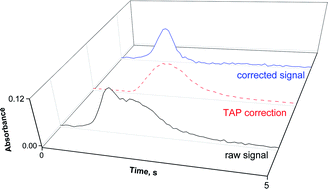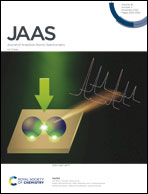Time-absorbance profile ratio background correction: introducing TAP to correct for spectral overlap in high-resolution continuum source graphite furnace atomic absorption spectrometry†
Abstract
High-resolution continuum source graphite furnace atomic absorption spectrometry HR CS GFAAS provides information about the vicinity of the analytical line, thus effectively transforming a 2-dimension technique (time versus absorbance) into a 3-dimension one (by adding wavelength information), which represents a key advantage when dealing with potential spectral overlaps. Indeed, the occurrence of diatomic molecule absorption often results in high background values in classical AAS, affecting many analyses. The high spectral resolution provided by HR CS AAS in this third dimension enables the use of new tools, first to detect and later to solve this problem. Currently, the software of commercially available HR CS AAS spectrometers is equipped with an algorithm for interference correction, the so-called least-squares background correction (LSBC). Using a spectrum from the interfering species as a correction model, LSBC can correct for the spectral interference by subtracting it. Nevertheless, this approach still poses some problems (e.g., the need to identify the overlapping species). Moreover, there is still a lot of information contained in every measurement that is essentially unused and can help in correcting for spectral overlaps. The time-absorbance profile (TAP) of a species, measured under the same instrumental HR CS AAS conditions using a GF as the atomizer, should be the same at every wavelength measured. Therefore, using a TAP normalized spectrum of the interfering species should be sufficient to subtract it from the normalized absorbance of the atomic line, leaving only the analytical signal of the analyte. This paper proposes the use of such an approach for the first time and discusses in detail how the TAP method can be deployed, without the need to perform any additional measurements or know in advance the nature of the overlapping species. The usefulness of TAP correction for circumventing spectral overlaps and reaching a good agreement with certified/reference values is demonstrated in various situations (e.g., direct determination of Pb in NIST 1570a spinach leaves and NIST 1577b bovine liver, of Ni in NIST 1573 tomato leaves, and of Cu in dried plasma spots produced from whole blood Seronorm™), and its current limitations are highlighted as well.

- This article is part of the themed collection: Young Analytical Scientists


 Please wait while we load your content...
Please wait while we load your content...